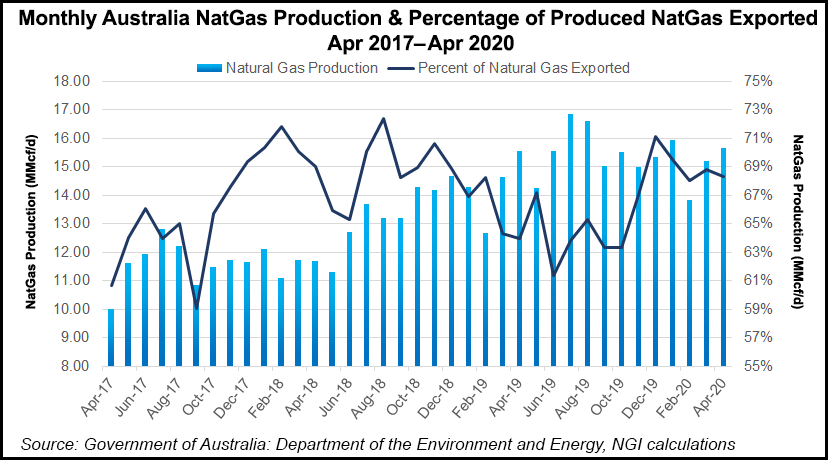E&P | LNG Insight | NGI All News Access | NGI The Weekly Gas Market Report
Woodside Writing Down Nearly $4B in Oil, Natural Gas Value including ‘Onerous’ Corpus Christi LNG Contract

Australia’s leading producer Woodside Petroleum Ltd. expects to impair close to $4 billion against the value of its portfolio, including one-time charges for its prized liquefied natural gas (LNG) projects, on reduced energy demand from Covid-19 and the subdued outlook for commodity prices.
Woodside said Tuesday it expects to record total impairments through the first half of 2020 of around $3.92 billion after tax, including $2.76 billion for the value of oil and gas properties and $1.16 billion for exploration and evaluation assets.
“Although these are difficult and uncertain times, the medium-term outlook for Woodside’s growth prospects and for our core product, natural gas, is positive,” CEO Peter Coleman said. “In the longer term, our commitment to innovation and new technologies will ensure we can also take advantage of emerging markets for hydrogen and ammonia, which will be a crucial part of the world’s transition to a lower-carbon future.
“LNG is advantaged as an energy source in a decarbonizing world.”
The biggest single impairment is close to $1 billion against the massive Wheatstone LNG project offshore Australia, which Chevron Corp. operates. Another one-time $1.6 billion charge is against four exploration assets, including the Sunrise gas project offshore East Timor and the still unsanctioned KM LNG export project in British Columbia.
In addition, Woodside is taking a $447 million impairment against an “onerous contract provision” in a sale and purchase agreement (SPA) from Cheniere Energy Inc.’s Corpus Christi LNG facility.
The Corpus impairment “reflects more closely connected global gas markets and Woodside’s view of likely reduced margins available between North American and other gas markets,” management said. “The applicable discount rate is the U.S. 20-year Treasury long-term bond rate.”
Six years ago Woodside secured a SPA with Corpus for 0.85 million metric tons/year. This year, with the pandemic curtailing demand and slumping prices, around 130 total cargoes from export projects in the Lower 48 were forecast to be canceled from May to October, based on a recent estimate from Poten and Partners.
Around 80% of Woodside’s charges have resulted from “the significant and immediate reduction in oil and natural gas prices assumed up to 2025, impacting Woodside’s products in the prevailing economic climate,” management said. “Additional contributors are increased longer-term demand uncertainty impacted by the Covid-19 pandemic and macroeconomic dynamics, and increased risk of higher carbon pricing.”
Woodside still remains in a “strong position to take advantage of opportunities which will inevitably arise both during and subsequent to this period of unprecedented market uncertainty,” Coleman said. “We’ve taken some tough decisions over recent months in response to the Covid-19 pandemic and oversupply in our key markets, but Woodside’s focus remains on cash preservation, capital discipline and maintaining the strength of our balance sheet. This will ensure we can deliver appropriate returns to shareholders and maintain our investment grade credit rating over the long term.”
As a result of the impairments, Woodside’s gearing at the end of June is expected to be about 19%. Gearing is the ratio of debt-to-equity, which shows the extent to which an operation is funded by lenders versus shareholders, i.e. financial leverage. Woodside’s target gearing range is 15-35%. The depreciation expense for oil and gas properties in the second half of 2020 is expected to decline by around $3/boe.
“We have low gearing and high liquidity, and announced significant expenditure reduction activities in March,” Coleman said. “The unique confluence of events that has unfolded through 2020 will challenge all participants in the global energy sector and we expect to see adjustment of capital allocation priorities by other asset owners as the cycle plays out.”
Woodside still has substantial financial wherewithal, he said, to “pursue inorganic growth opportunities as and when they emerge, at the same time supporting our strategy to develop the Scarborough and Browse gas resources located offshore Western Australia through our proposed Burrup Hub when the time is right.”
The final asset value review is to be published in the half-year report scheduled for Aug. 13.
© 2024 Natural Gas Intelligence. All rights reserved.
ISSN © 1532-1231 | ISSN © 2577-9877 | ISSN © 1532-1266 |


